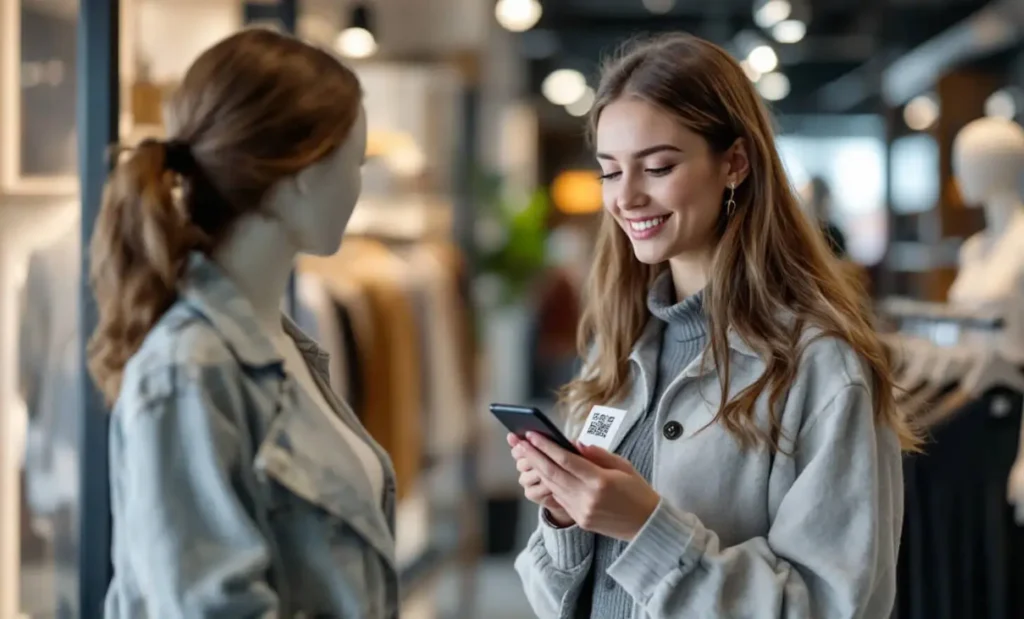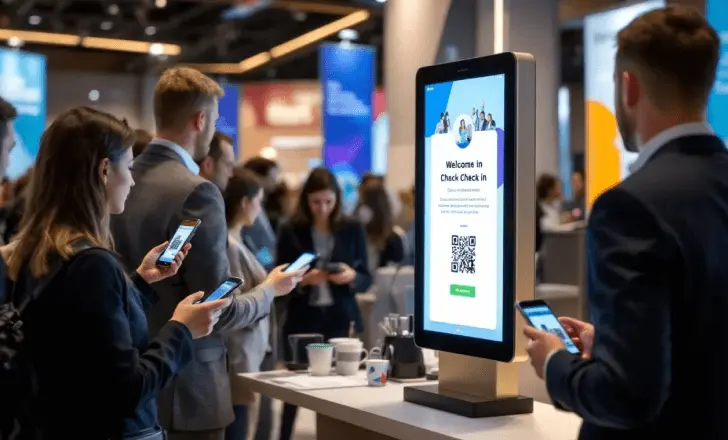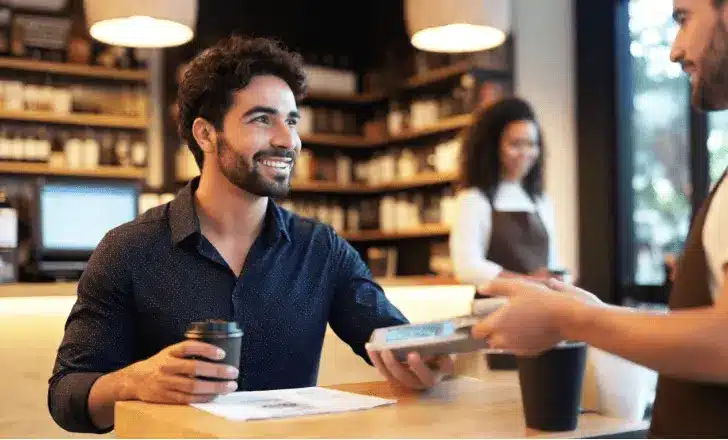What are QR codes?
QR codes—short for quick response codes—are compact, two-dimensional codes designed to store data in a way that’s lightning-fast to scan. First introduced by Denso Wave in Japan back in 1994, these little squares have come a long way from their industrial roots.
Today, they’re everywhere—from coffee cups to billboards—and they’ve quietly reshaped how we connect with the digital world. With just a quick point of your camera, most smartphones can scan a QR code and instantly pull up a website, app, or any kind of digital content. No typing. No searching. Just scan and go.
How QR codes work
A QR code—short for quick response code—is made up of dark and light areas arranged in a square grid. It might look like abstract art, but behind those little blocks is a powerful way to store and deliver data.
When you scan a QR code with a phone, QR code scanner, or any code reader, it instantly decodes the information inside. That can mean opening a web page, launching an app, connecting to a URL, showing instructions, or even initiating a mobile payment.
This is where QR code technology really shines. Instead of typing out a long website address or fumbling through menus, users just point, scan, and access what they need—fast. Whether it’s used on printed matter, packaging, or signage, a QR code makes using QR codes feel effortless.

Key QR codes facts
QR codes have evolved into more than just a tech trend—they’re a daily tool for millions. From marketing campaigns to mobile payments, they bridge the gap between the physical world and the web, offering fast, seamless access to detailed information with a simple scan. Let’s break down some of the most important QR codes facts shaping how businesses and consumers use this technology today.
QR codes facts
Global adoption
The global usage of QR code technology has exploded across industries—retail, healthcare, hospitality, logistics, and beyond. Why? Because QR codes are cost-effective, easy to use, and incredibly adaptable. Retailers use them to link to promotions and product pages. Logistics companies rely on them for shipment tracking. And across every sector, brands are using QR codes to enhance consumer engagement, manage inventory, and streamline operations.
Mobile-friendly
You no longer need a special app to start scanning QR codes. Today, most smartphones—whether iOS or Android—have built-in QR code scanners, making it easier than ever for users to connect with a web page, open a link, or access data on the go. This built-in functionality has helped QR codes become a standard in mobile devices, especially in marketing and digital store experiences.

Easily created
With the right QR code generators, like QR Code KIT, it takes seconds to create a QR code. From linking to a website, to setting up a digital menu, to organizing event check-ins, QR codes are easily created and just as easily implemented. This accessibility means that anyone—from major companies to independent creators—can take advantage of QR code tools without needing advanced software.
Versatile functionality
Don’t let their small size fool you—QR codes can carry a surprising amount of data. They can store URLs, plain text, payment details, Wi-Fi credentials, or even launch a mobile payment experience. Businesses use them for loyalty programs; educators use them to share learning materials. Whatever the use case, this two dimensional code adapts.
Security considerations
Yes, malicious QR codes exist—but that doesn’t mean scanning QR codes is unsafe. The key is caution: only scan from trusted sources, and check the URL before taking action. Reputable brands often use dynamic QR codes that include tracking and validation layers. For consumers, a quick peek at the link can help avoid scams. For companies, it’s about building trust through safe QR code implementation.
Sustainability
QR codes aren’t just smart—they’re sustainable. By replacing printed materials like brochures, receipts, or instructions, QR code usage helps businesses reduce paper waste. Instead of handing out flyers, companies can offer a single QR code on packaging that links to a website full of detailed information. This eco-friendly shift is gaining traction, especially among businesses prioritizing green initiatives.

Widespread payment method
QR code payments are now a global norm. Whether you’re using Apple Pay, Google Pay, WeChat Pay, or a local mobile wallet, QR code technology allows for secure, contactless transactions. For consumers, it means speed and convenience. For businesses, it’s a streamlined way to accept mobile payment without expensive hardware.
Popular in events and ticketing
Say goodbye to paper tickets. At concerts, conferences, and transit systems, QR codes are the new access pass. They enable real-time updates, smooth check-ins, and better control over ticket validation. Plus, they reduce fraud and printing costs—win-win for both event organizers and attendees.

Improved consumer engagement
A QR code isn’t just a shortcut—it’s a storytelling tool. Businesses are using QR codes to unlock exclusive content, activate promotions, and deliver interactive web experiences. Scan a label and you might land on a product video, a customer review page, or even a personalized offer. This kind of engagement builds loyalty and keeps customers coming back for more.
Used in healthcare
In the world of healthcare, QR codes are making operations faster and more reliable. Hospitals use them to manage patient records, link to test results, schedule appointments, and provide prescription information. One scan gives patients instant access to what they need—no paperwork, no waiting. It’s a small symbol with big potential to improve care.
Use cases of QR codes
The term QR code might sound technical, but its real power lies in how it’s used in everyday life. Across industries, brands continue to discover creative ways of using QR codes to connect with consumers, streamline operations, and deliver more detailed information. Here are a few real-world examples that show what’s possible with this versatile two dimensional code.
1. Enhancing customer engagement
Imagine sitting down at a restaurant and scanning a QR code on the menu. Instantly, you see ingredient details, nutrition facts, and even a suggested wine pairing—all on your mobile device. That’s not just convenience—it’s smart QR code technology at work.
Restaurants and retailers use QR codes like these to offer richer experiences: linking to feedback forms, loyalty programs, or exclusive promotions. It transforms a basic menu or product label into an interactive web page, boosting consumer engagement and encouraging repeat visits.
2. Smart business cards
Forget typing in contact info. A sleek QR code on a business card can link directly to a LinkedIn profile, personal website, portfolio, or even an online calendar. With one scan, your new contact has everything they need to stay in touch.
Professionals and companies alike use this method to make networking faster, more dynamic, and more mobile-friendly. With QR code generators, these smart cards are easily created, updated in real-time, and far more memorable than the paper-only kind.
3. Contactless payments
In small shops and global chains alike, QR code payments are taking center stage. A local store displays a QR code at checkout—customers scan it, choose their mobile payment app (like Apple Pay or Google Pay), and they’re done in seconds.
This contactless solution improves the checkout experience, boosts hygiene, and makes payments more secure. For businesses, it reduces cash handling and simplifies transaction tracking. For consumers, it’s fast, safe, and completely frictionless.

4. Interactive advertisements
In a crowded city square, a passerby spots a billboard with a QR code printed in the corner. One quick scan, and they’re taken to a limited-time offer, a behind-the-scenes video, or an AR-powered virtual try-on experience.
This is the new frontier of QR code marketing. With QR codes in advertising, businesses can turn static visuals into dynamic, trackable campaigns. Marketers gain insights from scan data—like time, location, and device—giving them the power to fine-tune ads based on real-world engagement. The same code can link to social media, sign-up pages, or custom landing pages that evolve over time.
5. Real estate listings
House-hunting just got a whole lot smarter. By adding QR codes to “For Sale” signs or window displays, real estate agents give potential buyers instant access to property details, high-res photos, and even virtual tours—all from their mobile devices.
No need to jot down addresses or search online. With QR code technology, buyers can explore listings on the spot, at their own pace. At open houses, agents can use QR codes to share interactive maps, mortgage calculators, or even a direct link to their contact page. It’s a seamless way to connect the offline world with the digital one.

6. Educational resources
From textbooks to classroom walls, QR codes are becoming everyday tools in schools and universities. Educators use them to link students directly to video lectures, online tutorials, and interactive quizzes—all accessible with a single scan from their mobile devices.
Instead of relying solely on printed material, teachers can embed QR codes into handouts and assignments to guide students to digital forums, collaborative platforms, or even live polls. This approach supports blended learning, caters to diverse learning styles, and makes it easier to share detailed information in real time. It’s not just smart—it’s how education stays connected in a digital age.
7. Smart packaging
Walk down any grocery aisle and you’ll likely spot it: a QR code on a snack bag, bottle, or cereal box. But this isn’t just about convenience—it’s about transparency. A food company can use a QR code on packaging to instantly deliver ingredient lists, nutritional facts, recipe ideas, and even insights into their sustainability practices.
With just a scan, consumers can explore sourcing information, allergen warnings, or eco-friendly certifications—all from their smartphones. This level of access not only builds trust, but also helps brands stand out in a crowded marketplace. In the world of printed matter, QR codes turn passive labels into active digital experiences.

8. Emergency information
When every second counts, QR codes can save lives. Public buildings now use these small two dimensional codes to provide instant access to emergency exit routes, safety protocols, and evacuation maps. A simple scan with a smartphone or QR code scanner can reveal vital instructions that might otherwise go unnoticed.
In disaster-prone areas, authorities are placing QR codes on signage to deliver real-time updates, emergency contacts, and location-specific guidance. It’s a fast, reliable way to make sure people get the detailed information they need, when they need it most.
9. Digital product manuals
Forget flipping through thick booklets. Today, many electronics manufacturers are replacing traditional manuals with QR codes printed directly on product packaging. One scan, and users can watch setup videos, browse FAQs, or download the latest digital guides—right on their mobile devices.
Not only does this cut down on printed matter and paper waste, it ensures that customers always have the most current support content at their fingertips. It’s one more way QR code technology improves the user experience and keeps support materials accessible.
10. Personal health tracking
In the world of fitness and wellness, QR codes are powering smarter, more connected routines. Wearable devices now include QR codes that sync with smartphone apps, allowing users to track their workouts, monitor key biometrics, and even receive tailored health insights in real time.
Whether you’re a seasoned athlete or just starting your wellness journey, QR code-enabled apps give you a clearer view of your progress. By turning raw data into actionable feedback, they help users stay motivated, informed, and on track toward their goals.

QR codes and innovation: What’s next?
The future of QR codes isn’t just bright—it’s bursting with potential. As global usage continues to rise, new applications are pushing the boundaries of what these small two dimensional codes can do. Let’s explore four trends that are redefining QR code technology and reshaping how businesses and consumers connect in the digital age.
1. Augmented reality (AR) integration
Scanning QR codes is about to get a whole lot more immersive. QR codes are now being used to trigger augmented reality experiences—think 3D product previews, interactive setup guides, or virtual try-ons that bring products to life right on your smartphone.
In retail, this means customers can scan a QR code on a product box and see how a chair looks in their living room or explore features in 3D before buying. It’s a bold new way of combining QR code functionality with cutting-edge visual tech.
2. Smart packaging and product transparency
Smart packaging is becoming a powerful tool for consumer engagement, and QR codes are at the heart of it. By placing a QR code on packaging, brands give shoppers instant access to ingredient lists, usage instructions, sourcing details, and even sustainability credentials.
This added layer of detailed information helps build trust—especially in industries like food, beauty, and pharmaceuticals—where transparency can influence every purchase decision.
3. Enhanced security with QR-based authentication
Forget passwords. QR codes are emerging as a secure way to log in, verify identity, and control access. From multi-factor authentication to passwordless logins, QR code-based systems give users a faster, safer way to manage digital identities.
For companies, this means fewer support headaches and stronger data protection. For consumers, it’s a simpler, smarter login experience—one scan and you’re in.
4. Dynamic QR codes for personalized marketing
Static is out. Dynamic QR codes are giving brands the power to update content in real time—without reprinting or redesigning anything. That means one code can adapt to different audiences, geographies, or timeframes.
Use it to rotate discount offers, manage digital menus, or serve up personalized marketing campaigns. Every time a user scans, they get the most relevant, up-to-date experience possible.
5. QR codes in the Internet of Things (IoT) ecosystem
As the world of smart devices expands, QR codes are becoming a quiet but essential player in the Internet of Things (IoT). From smart homes to connected cars, these two dimensional codes help bridge the physical and digital with just a scan—no tech degree required.
- Smart home automation: Picture this: You bring home a new smart thermostat, scan the QR code on the box with your mobile device, and within seconds, it’s linked to your app and synced to your Wi-Fi. No manuals. No guesswork. From security cameras to smart lights, QR code technology makes onboarding new devices as easy as pointing your phone.
- Industrial IoT (IIoT): In factories and warehouses, QR codes are powering serious efficiency. Teams use them to track inventory, schedule machine maintenance, and speed up logistics—often by scanning codes with IoT-enabled devices that feed real-time data into central dashboards. The result? Faster operations and fewer errors.
- Wearables and health tech: Whether it’s a smartwatch or a fitness tracker, today’s wearables are packed with features—and QR codes are helping unlock them. A quick scan can connect the device to an app, pull up exercise data, or even show emergency contacts. It’s all about making personal health tracking smoother and more accessible.
- Connected vehicles: In the age of smart cars, even your vehicle might come with a QR code. Drivers can scan to access the digital user manual, set up maintenance reminders, or activate digital car keys. It’s one more way that QR code functionality is making complex systems feel intuitive.
By integrating QR codes into the IoT ecosystem, businesses and consumers alike are simplifying control, increasing security, and enhancing usability. It’s another powerful example of how this compact code continues to evolve—quietly connecting everything from your fridge to your fitness band.
Why choose QR Code KIT?
Looking for a QR code generator that’s built for real-world business needs? QR Code KIT gives marketers, brands, and creators the tools to not just create QR codes, but to truly make them work.
Here’s what you can do with our platform:
- Create dynamic QR codes for everything from marketing campaigns to mobile payments—and update them anytime without reprinting.
- Track and analyze performance in real time, with insights into scanning behavior, locations, devices, and more.
- Customize every code to match your branding—add your logo, change colors, and make your QR codes stand out from the crowd.
- Integrate with ease, whether you’re embedding QR codes into product packaging, business cards, check-in systems, or promotional materials.
QR Code KIT makes using QR codes simple, smart, and scalable—whether you’re just getting started or managing thousands of codes across different channels.
Frequently asked questions (FAQ) about QR codes
1. What is the difference between a static and a dynamic QR code?
A static QR code holds fixed information—once it’s created, the data can’t be changed. That makes it useful for simple, one-time uses like contact details or Wi-Fi access.
A dynamic QR code, however, is far more flexible. It lets you update the content anytime, even after printing, and it supports features like scan tracking, analytics, and real-time redirection. That’s why dynamic QR codes are ideal for marketing, promotions, and evolving business needs.
2. Are QR codes free to use?
Yes—creating static QR codes is usually free, and there are plenty of QR code generators online to help you get started. These codes are great for basic, unchanging content.
But if you need dynamic QR codes with tracking, analytics, or the ability to change content later, you’ll typically need a subscription.
At QR Code KIT, a pioneer in dynamic QR technology, we offer a Free Plan that includes up to 2 dynamic QR codes—at no cost. It’s a risk-free way for businesses and individuals to explore the benefits of dynamic functionality without any upfront commitment.
3. Can QR codes store personal or sensitive information?
Yes, QR codes can store personal data, login credentials, or other sensitive information. But it’s important to do so securely. If you’re sharing sensitive info, make sure the QR code links to an encrypted, password-protected platform or website. Never store private data in plain text within a code.
4. Do QR codes expire?
Static QR codes don’t expire—they’ll work as long as the data they contain is still valid.
Dynamic QR codes, on the other hand, may come with time limits, depending on the QR code generator you’re using. Some platforms offer permanent usage, while others limit how long tracking or redirection features stay active.
5. Can QR codes be scanned without an internet connection?
Absolutely. QR codes that hold offline information—like plain text, contact cards, or Wi-Fi credentials—can be scanned and used without needing to be online.
However, if a QR code links to a web page, app, or any content hosted on the internet, you’ll need an active connection to access it.
6. How do I know if a QR code is safe to scan?
To avoid falling for malicious QR codes, follow a few simple rules:
- Only scan codes from trusted sources
- Use a QR code scanner that shows a preview of the URL before opening it
- Be cautious of random codes in public spaces—they could have been tampered with
QR code safety starts with awareness. When in doubt, don’t scan.

7. Can QR codes be customized?
Yes! QR codes don’t have to be boring black-and-white squares. With the right QR code generator, you can customize them with your brand colors, logos, and even creative design patterns—while keeping them fully scannable.
Custom QR codes help grab attention, align with your visual identity, and make the code instantly recognizable to your customers. Whether you’re launching a campaign or printing packaging, custom design adds real marketing value.
8. Are QR codes still relevant in 2025?
Absolutely. If anything, QR codes are more relevant than ever in 2025. Their use has skyrocketed across industries—from retail and marketing to healthcare, logistics, and education.
Thanks to the rise of contactless solutions, QR code technology has become a core part of modern business operations. It’s fast, accessible, and already built into most smartphones—which means adoption will only keep growing.
9. Can QR codes be printed on any material?
Yes, QR codes can be printed on a wide range of materials—paper, plastic, metal, fabric, and more. The critical factor is contrast: the code’s dark areas must stand out clearly against the background for a QR code scanner or mobile phone to read it properly.
Whether you’re printing on a label, a T-shirt, or a billboard, just make sure the design stays sharp and high-contrast. That way, every scan delivers.

10. What happens if part of a QR code is damaged?
Thanks to built-in error correction, QR codes can still work even if a portion of the code is scratched, smudged, or slightly damaged. Depending on the level of error correction used, a QR code scanner can often recover the full data—even if up to 30% of the code is missing.
That said, excessive damage or low print quality can make a QR code unreadable. Always test your printed codes before distribution to make sure they scan reliably across different devices and lighting conditions.
Get started with QR Code KIT today
Whether you’re launching a new marketing campaign, enabling QR code payments, or just want to boost customer engagement, QR Code KIT gives you the power to do more with less effort.
- Create and customize dynamic QR codes
- Track scans in real time with analytics
- Connect your QR codes to any web page, app, or business tool
Try QR Code KIT today and unlock the full potential of QR codes!
